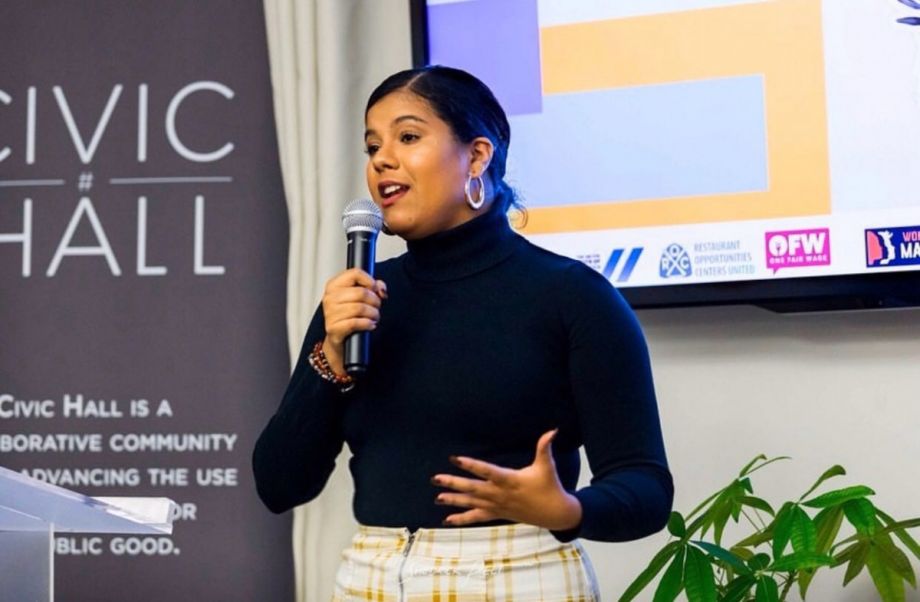Ilona Duverge is a 22-year-old organizer who recently graduated from John Jay College of Criminal Justice in New York City. She worked as a campaign staffer for Bronx Congresswoman Alexandria Ocasio-Cortez, and then co-founded Movement School, which runs training programs for activists and organizers. This fall, Movement School ran a 12-week program called Reclaim, offering organizing and leadership training for a dozen tenants of the New York City Housing Authority (NYCHA). Some of the fellows from the Reclaim program went to Washington, D.C., to stand with Ocasio-Cortez and Bernie Sanders when they introduced the Green New Deal for Public Housing Act. Last spring, Duverge says she began talking about that legislation with a legislative aide to Ocasio-Cortez, Randy Abreu, whose unsuccessful campaign for New York City Council Duverge managed in 2017.
Duverge was born in the Dominican Republic and raised in Scranton, Pennsylvania, before moving to New York. Here, Duverge talks with Next City about building political power, organizing with public housing tenants, and the Green New Deal. The conversation has been edited.
I think a lot of our readers know what organizers do or are organizers themselves, but just pretending they don’t, what does organizing look like for you with Reclaim NYCHA?
The role that we see ourselves playing is to be able to train and equip residents with the tools and the resources they need to organize for justice for NYCHA. NYCHA is the largest public housing authority in the entire country, and we truly believe that NYCHA tenants and public-housing residents across the country should be leading the housing-justice fight. What’s different about our training and our way of organizing is that we approach it as a very “train the trainers” model. This is why Movement School was even started, because we wanted campaigns and movements to be more representative of the communities that they’re fighting for. It would be a real disservice if I kind of just kept all of those skills and told people what to do and where to stand and what to say instead of actually investing in them to lead the movement. They are the ones closest to pain, so they should be the ones closest to the power.
What do you tell participants that they’re going to get out of it in terms of organizing skills?
We pitch it as building political power. One of the things that Movement School does is that it finds that intersection between movement and electoral, between issue and electoral, because we know that in order to really change things we need to change the faces of power. And we know that that means we need to be politically involved. When we look at NYCHA specifically, there’s so much misinformation that goes around among tenants about who is responsible for what. Unfortunately a lot of tenants blame the city or the state government, when in reality, public housing is federal — it’s under HUD, which means it’s our federal government. They should be looking at their congressmen or congresswomen to help. It’s a misconception that it’s De Blasio or it’s Cuomo. The game is at the federal level.
Finding that intersection, and being able to equip them with the tools and the resources and the skills that they need to fight at that level is what we’re here to do in order to actually bring solutions to the table. Something that I say to them always is that we can organize and we can scream from outside the dome that we want healthy housing and everything but if we’re actually not hitting them where it hurts which is organizing electorally to actually be able to change the [people] and make sure that they’re actually held accountable to the promises that they make and they’re actually putting public housing on the forefront, we’re never going to get everything done.
Can you tell me about the work you did on the AOC campaign and what the relationship between her Congressional office and former campaigners and organizers has been like?
During the primary I did field work, and during the general I was her deputy organizing director. AOC is at heart always an organizer and always putting organizers first because she knows how she won. It was by inspiring people on the ground to actually do the work. And I think that’s something that she’s always going to champion, organizing people on the ground, because she is an organizer. She gets that in order to create a sustainable movement and a movement made by the people, you need people. A couple Saturdays ago we had a launch for the Green New Deal for NYCHA at Pelham Parkway Houses in the Bronx, and that was her in her organizing element. This is something that she continues to do and the beauty of it is that everyone from the campaign is still around organizing and still engaged in what she’s been able to create. I really feel like she’s sort of this connective tissue between all of us.
The establishment and the right have things like the Democratic National Committee and the Democratic Congressional Campaign Committee that train and recruit and sustain the establishment, but we don’t have that on the progressive left. And that’s what we’re trying to build, between Movement School and Reach and Justice Democrats and the Sunrise Movement and other progressive-left organizations.
What kind of work did you do on the Green New Deal for Public Housing bill that she and Bernie Sanders introduced?
Our fellows got to play a really special role in that they were engaged from its inception. Because AOC’s office has this organizing mindset, they really believe when crafting legislation in giving the folks that they are trying to build legislation for an actual seat at the table. That’s the most powerful way to build legislation, is with the frontline communities that are actually most affected by it and getting the input from on the ground. When I was trying to figure out how to create Reclaim and what to do, and specifically the intersection between public housing and the Green New Deal, I came across Daniel Aldana Cohen’s article about green housing that he wrote for Jacobin. I was previously doing a lot of research on public housing, and when I read that article I was super-inspired. He was speaking about a small city and I was like, wait a minute, NYCHA is a small city — it has [400,000] people that live in it — what if we make NYCHA the first-ever green, no-carbon city?
There’s this thing called Section 3 that we can use to make sure that the tenants are the ones getting these contracts and doing the work, and working to eliminate the racial wealth gap by actually giving people good-paying union jobs and green jobs. I shopped that concept around to lots of tenants before anything, and tenants who actually went through the Section 3 program, so I got a lot of feedback. And I approached Ocasio-Cortez’s office and specifically the staffer that leads her Green New Deal portfolio, and they loved it.
So you went to them with the idea first?
Yeah. And they loved it, and they included the fellows every step of the way in writing the legislation. It was a beautiful thing to see. When they launched it in D.C. officially with Bernie and AOC, our fellows were right there, right behind her. One of our fellows spoke at the press conference, which was really cool, and then we had an event a couple of weeks ago in the Bronx.
A lot of people still think of public housing as the option of last resort and that it’s always in bad shape. Are you feeling hopeful that the perception of public housing and the reality of it can change over time?
Yeah. One of the goals of Reclaim specifically is also to humanize public housing again, because I feel like it has such a negative stigma. In the Reclaim program we really want to prove to people and show people that public-housing tenants are educators, they’re entrepreneurs, they’re caretakers. Public housing was once a good place and still in many ways continues to be, because it really is a community. People that don’t live in public housing don’t get it, from the outside looking in, but when you actually are on the inside, it is a community. People take care of each other’s kids, and people take care of each other in general. And people grow up with each other. And amazing people come out of public housing, so it’s really unfortunate that those families are living in those conditions. And tenants pay rent. They pay 30 percent of their income to live there, so they should have livable living conditions.
This article is part of Backyard, a newsletter exploring scalable solutions to make housing fairer, more affordable and more environmentally sustainable. Subscribe to our weekly Backyard newsletter.

Jared Brey is Next City's housing correspondent, based in Philadelphia. He is a former staff writer at Philadelphia magazine and PlanPhilly, and his work has appeared in Columbia Journalism Review, Landscape Architecture Magazine, U.S. News & World Report, Philadelphia Weekly, and other publications.
Follow Jared .(JavaScript must be enabled to view this email address)


















